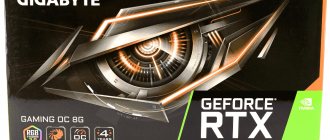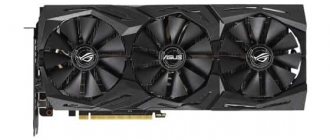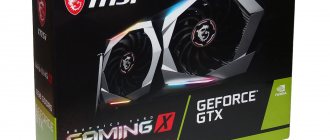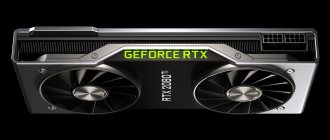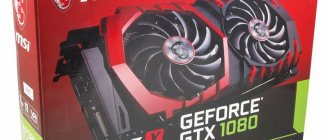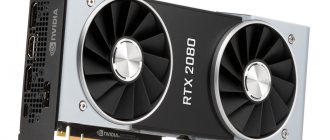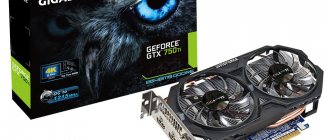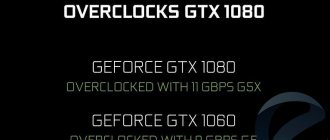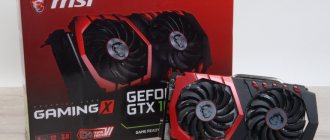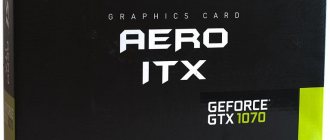The release of the new NVIDIA GeForce RTX 2070 SUPER and GeForce RTX 2060 SUPER video cards, as well as their competitors on AMD GPUs, has seriously shaken up the 3D graphics segment. On the secondary market, users began to massively put up regular GeForce RTX 2070 and GeForce RTX 2060 for sale in the hope of purchasing their updated versions at a profit, based on the fact that NVIDIA offers them for the same price as before, and in hardware conferences with a new Serious battles between fans of both companies flare up.
NVIDIA partner companies are even more active, releasing several variants of SUPER video cards on each chip. For example, Gigabyte, well known to our regular readers, announced four models each of the GeForce RTX 2070 SUPER and GeForce RTX 2060 SUPER, differing in circuit design, cooling systems, frequencies and design, and we have already managed to receive one of these video cards for testing. In today's article we will talk about the Gigabyte GeForce RTX 2070 SUPER Gaming OC.
It must be said right away that this is a relatively simple video card with conditional core overclocking and not the most powerful power system - all the cool stuff was left for the AORUS series video card. However, the Gigabyte GeForce RTX 2070 SUPER Gaming OC has everything it needs to win the hearts of gamers and make their wallets lighter.
⇡#Technical characteristics and recommended cost
The technical characteristics and cost of the Gigabyte GeForce RTX 2070 SUPER Gaming OC video card are shown in the table in comparison with the performance of the reference versions NVIDIA GeForce RTX 2080 FE and GeForce RTX 2070 FE. We did not include the reference version of NVIDIA GeForce RTX 2070 SUPER in the table, since the characteristics of the Gigabyte video card differ from it to the minimum extent.
| Name of technical characteristics | NVIDIA GeForce RTX 20 8 0 FE | Gigabyte GeForce RTX 2070 SUPER Gaming OC | NVIDIA GeForce RTX 2070 FE | |
| GPU | TU104-A1 Turing (TSMC) | TU10 4 -A1 Turing (TSMC) | TU10 6 -A1 Turing (TSMC) | |
| Technical process, nm | 12 FFN | 12 FFN | 12 FFN | |
| Crystal area, mm2 | 545 | 545 | 445 | |
| Number of transistors, billion | 13,6 | 13,6 | 10,8 | |
| GPU frequency, MHz | 3D | 1515 (1800 – boost) | 1605 (1815 – boost) | 1410 (1710 – boost) |
| 2D | 300 | 300 | 300 | |
| Number of unified shader processors, pcs. | 2944 | 2560 | 2304 | |
| Number of texture blocks, pcs. | 184 | 160 | 144 | |
| Number of raster operations blocks (ROPs), pcs. | 64 | 64 | 64 | |
| Number of tensor cores / RT cores, pcs. | 368 / 46 | 320 / 40 | 288 / 36 | |
| Ray tracing speed, GRay/s | 8 | 7 | 6 | |
| Theoretical maximum fill rate, Gpix./s | 115,0 | 116,2 | 111,4 | |
| Theoretical maximum texture sampling speed, Gtex. /With | 331,0 | 290,4 | 250,6 | |
| Supported memory type | GDDR6 | GDDR6 | GDDR6 | |
| Memory bus width, bits | 256 | 256 | 256 | |
| Effective video memory frequency, GHz | 3D | 14 | 14 | 14 |
| 2D | 0,81 | 0,81 | 0,81 | |
| Memory capacity, GB | 8 | 8 | 8 | |
| Video memory bandwidth, GB/s | 448,0 | 448,0 | 448,0 | |
| Peak power consumption in 3D operating mode, W | 3D | 225 | 215 | 185 |
| 2D | n/a | n/a | n/a | |
| Power supply power requirements, W | 650 | 650 | 550 | |
| Video card dimensions (L × H × T), mm | 267 × 102 × 39 | 289 × 105 × 50 | n/a | |
| Weight, g | n/a | 982 | n/a | |
| Interface | PCI-Express x16 (v3.0) | PCI-Express x16 (v3.0) | PCI-Express x16 (v3.0) | |
| Exits | 1 HDMI v2.0b, 3 DisplayPort v1.4a, USB-C (VirtualLink) | 1 HDMI v2.0b, 3 DisplayPort v1.4a, USB-C (VirtualLink) | 1 DVI-D, 1 HDMI v2.0b, 2 DisplayPort v1.4a, USB-C (VirtualLink) | |
| date of release | 19.09.2018 | 02.07.2019 | 19.09.2018 | |
| Recommended price at the time of announcement, US dollars | 699/799 | 499 | 499/599 | |
| Minimum retail price on the date of publication of the article, rub. | 49 990 | 39 770 | 35 990 | |
What about the characteristics?
The card is based on the NVIDIA Turing architecture. This means that it combines the technologies of ray tracing, artificial intelligence and programmable shading. The result is modern graphics and perfectly rendered lighting in the latest games.
Our test model is based on the NVIDIA TU104 video processor, which contains 2560 CUDA cores. The standard operating frequency of the video chip is 1605 MHz, but it can be overclocked to 1800 MHz in turbo mode. Our test model has 8 GB of GDDR6 video memory with a 256-bit bus.
According to representatives of Palit , thanks to the large number of cores and high frequency, the new 2070 Super is approximately 25% more productive than the reference device. Well, we still have to verify this statement in tests.
Well, let’s briefly go over the minimum stated requirements. The user must have at least 8 GB of RAM (16 GB is better), 1.5 GB of free hard drive space and a 650 W power supply. The operating system version must be at least Windows 7.
⇡#Packaging and accessories
Gigabyte GeForce RTX 2070 SUPER Gaming OC comes in a cardboard box, the design of which has already become standard for products from this company. Along with the image of a futuristic eye on its front side, the model of the video card is shown and individual icons highlight the features of this model.
The latter are described in more detail on the back of the box, where you can also find a list of video outputs and minimum system requirements.
The extremely brief characteristics of the video card are indicated on a sticker at the end of the box.
Below it shows the serial number of the video card, which can be compared with the serial number directly on the Gigabyte GeForce RTX 2070 SUPER Gaming OC cooler casing. You never know.
Another box is inserted inside the colored shell, only now black and made of thicker material.
It contains a soft shell made of foamed polyethylene, in the central part of which the video card is firmly fixed, additionally sealed in an antistatic bag. It is covered on top with a flat box with accessories, so you don’t have to worry too much about the safety of the product during shipment.
Included with the Gigabyte GeForce RTX 2070 SUPER Gaming OC you can find an extended warranty card, a disk with drivers and utility, and a quick guide.
There are no bonuses included in the package, however, using the included AORUS Care coupon, you can register the video card on the Gigabyte website to receive a warranty extended to four years. Interestingly, the Gigabyte GeForce RTX 2070 SUPER Gaming OC does not belong to the AORUS series, but there is a warranty.
Let us add that the video card produced in China is already sold in Russia at a price of just under 40 thousand rubles. In all well-known foreign online stores, they are asking less than 33 thousand rubles for the same model, but this does not take into account the cost of delivery and medications for nerves during shipment. However, we note that both the prices of the GeForce RTX 2070 SUPER are already lower than the prices of regular GeForce RTX 2070 at the start of sales, which is good news.
How much can you earn
To understand which algorithm, which coin is most profitable to mine and how much you will earn , use the online calculator - Whattomine.
Select the video card you need, indicate the number of these cards, then click on the name of the card itself so that it lights up (green or red, depending on the brand of the card - AMD or Nvidia), scroll down the page and click on the “Calculate” button. Next, the system will give you the most profitable coins for mining!
At the time of writing, it is most profitable to mine the following coins on the 2070S:
- Zcoin(XZC)
- Swap(XWP)
- Grin-CR29(GRIN)
- MWC-CR29(MWC)
- Zel(ZEL)
⇡#PCB design and features
The design of the new Gigabyte GeForce RTX 2070 SUPER Gaming OC largely repeats the design of the company's previous Gaming series video cards. Small differences can only be noticed in the gray inserts on the cooler casing on the front side and in the top cover of the same color, where the backlight is located.
The video card turned out to be of moderate size - only 289 × 105 × 50 mm, but it weighs quite decently - 982 grams.
Of the video outputs, the Gigabyte GeForce RTX 2070 SUPER Gaming OC has one HDMI version 2.0b, three DisplayPort version 1.4a, and one USB 3.1 Gen2 Type C (VirtualLink) port for connecting virtual reality devices.
At the same time, on the panel with the outputs there is space left for the grille to allow the heated air to flow outside the system unit case.
The opposite end of the video card is half covered with a plastic casing, but you can see both the radiator and its heat pipes.
Two power connectors - six- and eight-pin - are located on the upper edge of the PCB, conveniently oriented with latches outward and have indicators of correct operation.
The maximum power consumption level of the Gigabyte GeForce RTX 2070 SUPER Gaming OC should not exceed 215 watts. This is already 30 watts higher than the regular GeForce RTX 2070, but still 10 watts lower than the reference GeForce RTX 2080. The power supply in the system where one such video card will be installed must be at least 650 watts. “One” was not added by chance, since the GeForce RTX 2070 SUPER has an NVLink interface connector, with which you can combine two such video cards in SLI mode.
In this case, you will need a power supply with a power of at least 850 watts.
The length of the video card printed circuit board is 265 mm. The arrangement of the elements is very dense on both the front and back sides of the PCB.
The board is based on the proprietary Ultra Durable VGA concept, which involves the use of only high-quality and durable components and PCB with double the thickness of copper layers.
The video card power supply system is ten-phase. Eight phases, composed of solid capacitors and field-effect transistors with an integrated driver, are allocated to the graphics processor, and two more to video memory and power circuits.
Two eight-phase uP9512 controllers manufactured by uPI Semiconductor are responsible for power management, one of which is soldered on the front side of the PCB, and the second on the back.
Nearby you can see two NCP45491 controllers manufactured by ON Semiconductor, which are responsible for voltage regulation. In the circuit design of the board, one more chip can be distinguished - Holtek HT32F52241.
Apparently, it is entrusted with the functions of monitoring the video card and controlling the backlight.
I was pleased with the fact that the amount of thermal paste on the GPU was optimal, and in color and consistency it was reminiscent of ARCTIC MX-4, only it was less thick. But the absence of a protective frame around the perimeter of the GPU substrate is not a very pleasant fact.
In the main review of the GeForce RTX 2070 SUPER, we have already told you how the GPUs of this video card differ from the regular GeForce RTX 2070. About the Gigabyte GeForce RTX 2070 SUPER Gaming OC, we can add to it that the forced frequency of its GPU is 1815 MHz (+2.5% ) versus 1770 MHz for the reference version. The base frequency remains unchanged - it is equal to 1605 MHz. Such overclocking can be called conditional, that is, formally it seems to exist, but the effect from it will be barely noticeable. Nevertheless, due to these 45 MHz, the video card received the OC index. By the way, the most productive version of the GeForce RTX 2070 SUPER from Gigabyte can increase the core frequency in boost mode to 1905 MHz.
As we know, there have been no changes to the video memory subsystem of the GeForce RTX 2070 SUPER. This is echoed by NVIDIA and Gigabyte, which did not optimize anything and overclock the already fast 8 GB GDDR6 on a 256-bit bus, capable of “pumping” 448 gigabytes per second. Here the memory is equipped with 9EA77 D9WCW microcircuits manufactured by Micron Technology.
Their effective frequency is 14 GHz, and, as practice shows, such microcircuits have a good frequency margin for overclocking, which we will definitely check today.
The intermediate result of the review of the Gigabyte GeForce RTX 2070 SUPER Gaming OC will be summed up by the GPU-Z utility with the characteristics of the video card.
Thermal photographs
All thermal images were taken under maximum load for a general overview and understanding of the cooling system with a slight overclocking of the core and memory.
The thermal performance of the Windforce 3X cooler is simply fantastic. The GPU peaked at just 62C, which is 3 degrees lower than the Gaming X Trio and 11 degrees lower than the Founders Edition.
Our thermal camera showed no problems in the cooling system of this video card. Hot spots did not exceed 64 degrees. Both results are impressive.
In general, the overall impression of the cooling system is positive, but it is worth understanding that the card was installed alone in an open stand.
⇡#Cooling system
Since the frequency formula of the Gigabyte GeForce RTX 2070 SUPER Gaming OC differs minimally from the standard, Gigabyte places the main emphasis in this model of video card on its cooling system. And this is not trivial marketing, since the new version of the branded cooler WindForce 3X really deserves attention.
The cooling system consists of four components: a plastic casing with fans, an aluminum radiator with heat pipes, a heat distribution plate for memory chips and VRM elements, as well as a plate on the back side of the PCB.
The aluminum radiator is composed of three sections, each of which is composed of thin aluminum plates with an interfin distance of just over 1 mm.
The central section is located directly above the GPU and is penetrated by two heat pipes with a diameter of 7 mm. The two side sections each received four heat pipes - however, they were the same ones. That is, there are six heat pipes in total. Without exception, all joints between tubes and plates in the radiator are soldered.
By the way, this radiator uses composite heat pipes, inside of which there is an additional boundary layer that accelerates heat transfer several times, thereby increasing the efficiency of heat transfer and reducing the temperature of the heat source.
The base of the radiator is made using direct contact technology with virtually no gaps between the tubes. Yes, as practice shows, this is not the best option for open GPU crystals, and other manufacturers have already abandoned direct contact in video cards, but for some reason Gigabyte decided differently.
A metal plate with thermal pads is screwed to the aluminum blank at the base, designed to reduce the temperature of the video memory chips. The VRM elements are cooled by separate fins adjacent to the main heatsink.
To cool the radiator, it has a plastic frame with three fans and customizable RGB Fusion 2.0 lighting, which adds color to the GIGABYTE inscription at the top.
The diameter of the fan impellers is 82 mm, and their main feature is the proprietary Alternate Spinning technology, which consists of rotating the central and side impellers in different directions.
This fan rotation pattern allows for optimal distribution of turbulent flows and more efficient directing of air to the radiator and printed circuit board.
In addition, fan blades have fins at the ends, notches on the outer surface of the blades, and a serrated edge at the air flow outlet. According to the developers, such blades make it possible to increase the level of static pressure of the fan, which is exactly necessary for such a dense radiator.
The fan speed is changed automatically using the 3D Active system. Essentially, this is a monitoring system that stops “turntables” in no-load modes at low temperatures. Its purpose is to make the graphics card quieter when running in 2D modes, and 3D Active really solves this problem. However, we are not supporters of this approach for two reasons.
The first is the fact that in a system case, high-quality fans of this diameter and thickness will not be heard at all even at 800 or 1000 rpm. Why then stop them completely? Second, just try to touch the back of such a video card when it is running in 2D with the fans stopped. Immediately make sure that the video card is hot, its temperature even on the reverse side is at least 55 degrees Celsius, and inside such a convection-cooled radiator the temperature is even higher! How long will the VRM circuit components or the GPU itself last under such conditions? Maybe long enough, but why take the risk? Manually setting the operating mode of the cooler fans with a minimum speed limit of 1000 rpm completely solves this problem, reducing idle temperatures by 20 degrees Celsius, and at the same time, even inside the system unit case, the video card is just as inaudible as it is not can be heard with the fans stopped. Therefore, in our opinion, 3D Active and similar technologies from other video card manufacturers are quite controversial.
To check the temperature conditions of the video card as a load, we used the Fire Strike Extreme stress test from the latest version of the 3DMark graphics package.
To monitor temperatures and all other parameters, the MSI Afterburner program and the GPU-Z utility were used. The tests were carried out in a closed system unit case, the configuration of which you can see in the next section of the article, at a room temperature of about 27.5 degrees Celsius.
First, we checked the temperature conditions of the Gigabyte GeForce RTX 2070 SUPER Gaming OC with automatic adjustment of the WindForce 3X cooler fan speed.
Automatic mode (0–1710 rpm, 3 pcs.)
In idle mode, the cooler fans stop, so the GPU temperature is at 55 degrees Celsius. We talked about this above. When starting a 3D application, when the GPU temperature exceeds 55 degrees Celsius, the fans start and begin to cool the video card and its elements, accelerating to a speed of 1710 rpm. As a result, the temperature of the video card’s GPU freezes at 66 degrees Celsius. That is, the difference between the modes without load and under load is only 11 degrees Celsius. In our opinion, this is not entirely correct, although WindForce 3X copes with its task perfectly under load. Just don't stop her fans in 2D and everything will be fine. Fortunately, in MSI Afterburner you can manually build a curve of the dependence of fan speed on temperature using as many as eight points. For example, like this.
This setting allowed us to reduce the GPU temperature at idle to 32 degrees Celsius (by 23 degrees at once!), and under load it did not exceed 64 degrees. However, I don’t know, maybe someone needs to stop the fans completely in 2D...
It remains to check the temperature conditions of the Gigabyte video card at maximum fan speed.
Maximum speed (~3100 rpm, 3 pcs.)
The maximum temperature of the GPU decreased by 11-12 degrees Celsius with a peak of 55 degrees. Of course, the noise level of a video card in this mode is very high, and hardly anyone will use it constantly, except perhaps to reach the maximum frequencies when overclocking to improve performance in benchmarks. By the way, about overclocking.
Windforce cooling system just whispers
The cooling system, called Windforce 3X, ensures not only low temperatures, but also low operating noise. The middle cooler rotates in the opposite direction compared to the other two, which increases cooling efficiency. Without load, the fans do not rotate and only the radiator easily copes with heat removal. Under full load, the coolers are barely audible in a closed case. Of course, it's not the quietest example we've had, but you have to understand that such a high-performance chip requires a serious cooling system, which will be a little noisy anyway.
Of course, a graphics card in this price segment cannot lack backlighting. Gigabyte calls this system RGB Fusion 2.0 and it allows you to synchronize lighting effects with other Aorus devices.
The maximum level of power consumption of the test system under full load reached 217 W, which is a very low figure compared to other modifications.
⇡#Overclocking potential
First, we checked the overclocking potential of the GPU using an automatic scanner from MSI Afterburner (by Alexey Nikolaychuk) version 4.6.2 beta 2 build 15658. The speed of the cooler fans was adjusted automatically, and the power and temperature limits were increased to the maximum possible. The result was as follows.
The scanner reported a possible increase in core frequency by only 41 MHz. This can hardly be called overclocking, so we switched to manual overclocking.
After a couple of hours of testing, we were able to find out that without loss of stability or appearance of image defects, the GPU frequency can be increased by 120 MHz, or 7.5% of the base frequency, and the video memory frequency by 1840 MHz, or 13.1%.
Pretty good, in our opinion. The frequencies of the overclocked video card were 1725-1935/15840 MHz.
According to monitoring data, the maximum frequency of the overclocked GPU briefly reached 2130 MHz, and then stabilized at 2055-2070 MHz. At the same time, manually adjusted cooler fans were able to keep the GPU temperature two degrees Celsius lower than without overclocking.
Automatic mode (1100-1990 rpm, 3 pcs.)
In other words, the Gigabyte GeForce RTX 2070 SUPER Gaming OC has good overclocking potential, which, with additional adjustment of the cooling system fans, does not lead to an increase in temperatures and allows you to achieve more stable frequencies, and therefore a slightly higher level of performance.
What to mine on RTX 2070? Selects the most profitable algorithm
Now let’s find out how profitable mining of Ethereum and other altcoins will be in 2070. For reference, altcoins are all cryptocurrencies except the “patriarch” coin Bitcoin. However, large blockchain networks such as Ethereum and Monero have many of their own cryptocoins created on the basis of the main coin. But it all started with BTC.
And so, hashrate according to mining algorithms:
| Algorithm | Cryptocurrency | RTX 2070 SUPER hashrate | GTX 1070 hashrate |
| Ethash Mh/s | Ethereum | 42 | 30 |
| MTP Kh/s | Zcoin | 2800 | 1800 |
| Cuckaroo 29 Gh/s | Grin | 4.8 | 4.4 |
| Eqihash 144_5 sol/s | Bitcoin Gold | 60 | 56 |
| Eqi1sh 150_5 sol/s | Beam | 47 | 24 |
| Eqihash 192_7 sol/s | Zero | 34 | 23 |
| ProgPow/KawPow Mh/s | Bitcoin Interest/ Ravencoin | 21 | 12 |
| BCD Mh/s | Bitcoin Diamond | 27.5 | 19.9 |
| X16R Mh/s | Veil | 24.5 | 17 |
| NeoScrypt Kh/s | Vivo (VIVO) | 2000 | 1250 |
The RTX 2070 develops a very decent speed in cryptocurrency mining. The video card was able to seriously surpass not only the GTX 1070 , but also the RTX 2060 . On YouTube channels and mining forums you can see quite a lot of tests that clearly confirm the numbers in our article. Now we will determine what to mine for 2070 and show you a list of profitable coins. We indicate the amount of profit per day in US dollars, without deducting the cost of electricity.
- Ethereum (ETH) – $3.70;
- BitTubeCash (TUBE) – $3.26;
- Swap (XWP) – $3.10;
- Aeternity (AE) – $2.82;
- Firo (XZC) – $2.79;
- Conflux (CFX) – $2.60;
- Veil-ProgPow (VEIL) —2.22 $;
- MWC-CT31 (MWC) - $2.19;
- Grin-CT32 (GRIN) – $1.88;
- Ravencoin (RVN) – $1.85;
- Zano (ZANO) – $1.55;
The WhatToMine mining calculator shows the current profitability of coins; tomorrow the indicators may be slightly different. Until Ethereum exceeded $1000, mining it on Nvidia cards was not very profitable, but now everything has changed. As of January 31, 2021, ETH is the most profitable coin to mine on almost all GPUs. However, as for the rest of the altcoins of the Ethash algorithm, on ETC, or any other token, green miners traditionally have lower income than red miners.
When a lot of Ether goes to PoS, the rigs collected on Nvidia will have to be transferred to MimblVimble forks. MTP or the new Octopus algorithm. Or maybe new profitable coins will appear. Dual mining on the 2070 could be very profitable 2 years ago, the card practically does not lose Ethereum hashrate in dual mining, but now this is no longer relevant. You can activate combined ETH+Zill mining on the pool https://ezil.me/ or https://zil.rustpool.xyz/ and then you will receive Zilliqa coins in addition to ether.
Co-mining differs from traditional dual mining in that your rig is not running on two blockchains at the same time, but periodically switches between mining the Ethereum main coin and mining the Zilika coin.
The Zill coin uses a combined POS+POW consensus algorithm, so miners are only needed to service this network occasionally, for short periods of time. After working for 10-15 minutes on Zilliqa, the miner automatically switches to Ether until the next window. Thus, without losing anything on ETH, you earn several Zill crypto coins.
⇡#Test configuration, tools and testing methodology
Testing of video cards was carried out in a closed system unit case on the following hardware configuration:
- motherboard: ASRock X299 OC Formula (Intel X299 Express, LGA2066, BIOS P1.60 dated 11/01/2018);
- CPU: Intel Core i9-7900X 3.3-4.5 GHz (Skylake-X, 14 nm, U0, 10 × 1024 KB L2, 13.75 MB L3, TDP 140 W);
- CPU cooling system: Phanteks PH-TC14PE (2 × Corsair AF140, 760~1090 rpm);
- thermal interface: ARCTIC MX-4 (8.5 W/(m K);
- RAM: DDR4 4 × 4 GB Corsair Vengeance LPX 2800 MHz (CMK16GX4M4A2800C16) (XMP 2800 MHz/16-18-18-36_2T/1.2 V or 3000 MHz/16-18-18-36_2T/1.35 V) ;
- video cards: NVIDIA GeForce RTX 2080 Founders Edition 8 GB/256 bit, 1515-1800(1965)/14000 MHz;
- Gigabyte GeForce RTX 2070 SUPER Gaming OC 8 GB/256 bit, 1605-1815(1965)/14000 MHz and overclocked to 1725-1935(2070)/15840 MHz;
- NVIDIA GeForce RTX 2060 SUPER Founders Edition 8 GB/256 bit, 1470-1650(1830)/14000 MHz;
- NVIDIA GeForce RTX 2060 Founders Edition 6 GB/192 bit, 1365-1680(1830)/14000 MHz;
- NVIDIA GeForce GTX 1070 Ti 8 GB/256 bit 1607-1683(1823)/8008 MHz;
- for system and benchmarks: Intel SSD 730 480 GB (SATA III, BIOS vL2010400);
To reduce the dependence of video card performance on the platform speed, the 14-nm ten-core processor with a multiplier of 44 , a reference frequency of 100 MHz and the Load-Line Calibration function activated at the highest level was overclocked to 4.4 GHz while the voltage in the motherboard BIOS was increased to 1.119 V.
In turn, 16 gigabytes of DDR4 RAM operated in four-channel mode at a frequency of 3.2 GHz with main timings of 15 -16-16-32 CR 1 at a voltage of 1.35 V and adjustment of individual secondary timings.
We will evaluate the performance of the Gigabyte GeForce RTX 2070 SUPER Gaming OC in comparison with the performance of the reference NVIDIA GeForce RTX 2080 Founders Edition and NVIDIA GeForce RTX 2060 SUPER Founders Edition.
I would, of course, like to add a regular GeForce RTX 2070, but I didn’t have it at my disposal. However, taking into account the fact that we have fresh comparison results of such video cards in the basic article, this can hardly be considered a serious drawback of today’s material. In addition, the tests included the NVIDIA GeForce RTX 2060 Founders Edition, and from the previous generation video cards - the NVIDIA GeForce GTX 1070 Ti at standard frequencies.
Let's add that the power and temperature limits on all video cards were increased to the maximum possible, and in the GeForce drivers, instead of optimal power consumption, maximum performance was prioritized. We will also be happy to include video cards based on AMD GPUs in the tests as soon as they begin to arrive to us in original versions for reviews.
Testing, which began on July 23, 2022, was conducted using the Microsoft Windows 10 Pro 1903 operating system with all updates as of that date and the following drivers installed:
- motherboard chipset Intel Chipset Drivers – 10.1.18019.8144 WHQL from 05/03/2019;
- Intel Management Engine Interface (MEI) – 1923.12.0.1278 WHQL dated 06/20/2019;
- Video card drivers for NVIDIA GPUs – GeForce 431.36 WHQL from 07/09/2019.
In today's testing, we only used the 2560 x 1440 pixel resolution. For the tests, two graphics quality modes were used: “Quality + AF16x” - default texture quality in the drivers with 16x level anisotropic filtering enabled and “Quality + AF16x + MSAA 4x” with 16x level anisotropic filtering enabled and full-screen anti-aliasing using the MSAA algorithm 4x degree . In some games, due to the specifics of their game engines, other anti-aliasing algorithms were used, which will be indicated later in the methodology. Anisotropic filtering and full-screen anti-aliasing were enabled in the game settings. If these settings were not available in games, then the parameters were changed in the GeForce driver control panel. Vertical synchronization (V-Sync) was also forcibly disabled there. Apart from the above, no additional changes were made to the driver settings.
The video cards were tested in two graphics tests and in fifteen games, updated to the latest versions as of the date of preparation of the material. The list of test applications is as follows (the games and then the test results in them are arranged in the order of their official release):
- 3 DMark (DirectX 9/11/12) – version 2.9.6631, tested in the Fire Strike Extreme, Fire Strike Ultra, Time Spy Extreme and Port Royale scenes (graphics score is shown in the diagram);
- Unigine Superposition (DirectX 11) – version 1.0, tested in 1080P High, 1080P Extreme and 4K Optimized presets;
- Deus Ex : Mankind Divided (DirectX 12) – version 1.19 build 801.0, all quality settings are manually set to the maximum level, tessellation and depth of field are activated, at least two consecutive runs of the benchmark built into the game;
- For Honor (DirectX 11) – version 70.113, maximum graphics quality settings, volumetric lighting – MHBAO, dynamic reflections and blur effect enabled, oversampling anti-aliasing disabled, tests without anti-aliasing and with TAA, double sequential run of the benchmark built into the game;
- Tom Clancy 's Ghost Recon Wildlands (DirectX 12) – version 1.6.0, graphics quality settings to maximum or Ultra level, all options activated, tests without anti-aliasing and with SMAA+FXAA, double sequential run of the benchmark built into the game ;
- Warhammer 40,000: Dawn of War III (DirectX 11) – version 4.0.0.19122, all graphics quality settings at the maximum level, anti-aliasing activated, but in AA mode resolution scaling was used to 150%, double sequential run of the benchmark built into the game;
- Call of Duty : WWII (DirectX 11) – version 1.24.01, all graphics quality settings at extra level, shadows enabled, testing without anti-aliasing and with the SMAA T2X option activated, a double run of the introductory scene of the first stage of D-Day was used, FRAPS 105 seconds;
- Strange Brigade (DirectX 12) – version 1.47.22.14, settings level “Ultra”, all quality improvement techniques are activated, asynchronous calculation is enabled, two consecutive cycles of testing the built-in benchmark without anti-aliasing and with its activation;
- Shadow of the Tomb Raider (DirectX 12) – version 1.0 build 292, all parameters set to “Ultra” level, Ambient Occlusion – HBAO+, tessellation and other quality improvement techniques activated, two cycles of built-in benchmark tests without anti-aliasing and with SMAA4x activated;
- Assassin's Creed Odyssey (DirectX 11) – version 1.51, the benchmark built into the game was used with the Ultra High settings profile and dynamic resolution disabled, the test was run twice without anti-aliasing and with anti-aliasing at the High level;
- HITMAN 2 (DirectX 12) – version 2.40.0, built-in test at the “Ultra” detail level, SSAO enabled, “Ultra” shadow quality, memory protection disabled, test scene – “Miami”;
- Metro Exodus (DirectX 12) – version 0.1.0.17, built-in performance benchmark, Ultra and RTX settings profiles, double sequential run of the test scene;
- Far Cry New Dawn (DirectX 12) – version 1.0.2, all settings to the maximum quality level – Ultra and High, motion blur activated, built-in performance test without anti-aliasing and with TAA activated;
- Tom Clancy's The Division 2 (DirectX 12) – version 1.0.4, frame limit disabled, all settings set to maximum quality level, projected texture resolution – 512, built-in performance test;
- World War Z (DirectX 11) – version 1.21, FPS limitation disabled, all settings at Ultra level, built-in performance benchmark without anti-aliasing and with TAA activated;
- Total War : Three Kingdoms (DirectX 11) – version 1.1.0, maximum graphics quality, shadow detail and squad size at the “Extreme” level, built-in performance benchmark without anti-aliasing and with TAA activated;
- F1 2019 (DirectX 12) – version 1.06, used the built-in test on the Albert Park circuit in Australia in clear weather, graphics quality settings were set to the maximum level for all points, SSRT shadows were activated, test without anti-aliasing and with TAA.
Let's add that if games implement the ability to record the minimum number of frames per second, then it is also shown in the diagrams. Each test was carried out twice; the best of the two values obtained was taken as the final result, but only if the difference between them did not exceed 1%. If the deviations of the benchmark runs exceeded 1%, then testing was repeated at least one more time to obtain a reliable result. Performance test results
Let's supplement the constructed diagrams with a final table with test results showing the average and minimum number of frames per second for each video card.
We will analyze the results using summary diagrams.
Review of the Gigabyte GeForce RTX 2070 Super Gaming OC 8G (8 GB) video card
Research object : Mass-produced 3D graphics accelerator (video card) Gigabyte GeForce RTX 2070 Super Gaming OC 8G 8 GB 256-bit GDDR6
Briefly about the main thing
A traditional view of the overall performance of the card and its rivals, subjectively assessed by us on a scale of five gradations.
Our numerous studies have shown that the Nvidia GeForce RTX 2070 runs most games at maximum quality settings in resolutions up to 2.5K inclusive. The GeForce RTX 2080, which was previously one level higher, feels great at 2560x1440, and can also “swing” at 4K with maximum graphics quality in a number of games, and the new GeForce RTX 2070 Super, “wedged” between them, is also excellent at 2.5K resolution , but in order to play comfortably in 4K, in many particularly graphically complex games, you may have to degrade the quality - or return to 2.5K in order to maintain maximum graphics quality.
Card characteristics
Gigabyte Technology (Gigabyte brand) was founded in 1986 in the Republic of China (Taiwan). Headquarters in Taipei/Taiwan. Initially created as a group of developers and researchers. In 2004, the Gigabyte holding was formed on the basis of the company, which included Gigabyte Technology (development and production of video cards and motherboards for PCs); Gigabyte Communications (production of communicators and smartphones under the GSmart brand (since 2006).
| Gigabyte GeForce RTX 2070 Super Gaming OC 8G 8GB 256-bit GDDR6 | ||
| Parameter | Meaning | Nominal value (reference) |
| GPU | GeForce RTX 2070 Super (TU104) | |
| Interface | PCI Express x16 | |
| GPU operating frequency (ROPs), MHz | 1410—1620(Boost)—1850(Max) | 1605—1770(Boost)—1950(Max) |
| Memory operating frequency (physical (effective)), MHz | 3500 (14000) | 3500 (14000) |
| Memory bus width, bits | 256 | |
| Number of computational units in the GPU | 40 | |
| Number of operations (ALU) per block | 64 | |
| Total number of ALUs | 2560 | |
| Number of texturing units (BLF/TLF/ANIS) | 160 | |
| Number of rasterization units (ROP) | 64 | |
| Number of Ray Tracing blocks | 40 | |
| Number of tensor blocks | 320 | |
| Dimensions, mm | 285×100×50 | 270×100×36 |
| Number of slots in the system unit occupied by a video card | 3 | 2 |
| PCB color | black | black |
| Peak power consumption in 3D, W | 215 | 217 |
| Power consumption in 2D mode, W | 30 | 34 |
| Energy consumption in sleep mode, W | 10 | 11 |
| Noise level in 3D (maximum load), dBA | 31,2 | 31,2 |
| Noise level in 2D (video viewing), dBA | 18,0 | 26,2 |
| Noise level in 2D (idle), dBA | 18,0 | 26,0 |
| Video outputs | 1×HDMI 2.0b, 3×DisplayPort 1.4, 1×USB-C (VirtualLink) | 1×HDMI 2.0b, 3×DisplayPort 1.4, 1×USB-C (VirtualLink) |
| Multiprocessing support | SLI (NV Link) | |
| Maximum number of receivers/monitors for simultaneous image output | 4 | 4 |
| Power: 8-pin connectors | 1 | 1 |
| Power: 6-pin connectors | 1 | 1 |
| Maximum resolution/frequency, Display Port | 3840× [email protected] Hz (7680× [email protected] Hz) | |
| Maximum resolution/frequency, HDMI | 3840× [email protected] Hz | |
| Maximum resolution/frequency, Dual-Link DVI | 2560× [email protected] Hz (1920× [email protected] Hz) | |
| Maximum resolution/frequency, Single-Link DVI | 1920× [email protected] Hz (1280× [email protected] Hz) | |
| Average price of a Gigabyte card | at the time of writing - 40,000 rubles. | |
Memory
The card has 8 GB of GDDR6 SDRAM memory located in 8 8 Gbit chips on the front side of the PCB. Micron memory chips (GDDR6) are designed for a nominal operating frequency of 3500 (14000) MHz.
Card Features and Comparison with Reference Design
| Gigabyte GeForce RTX 2070 Super Gaming OC 8G (8 GB) | Nvidia GeForce GTX 2070 Super Founders Edition (8 GB) |
| front view | |
| back view | |
Overall the design of the Gigabyte card and the reference card are very similar.
The power supply circuit is based on an 8-phase digital converter iMon DrMOS. This dynamic power management system is capable of monitoring current more than once per millisecond, giving tight control over the power supplied to the core. This helps the GPU run at higher frequencies for longer. The same converter implements 2-phase power supply to memory chips.
The standard memory operating frequencies are equal to the reference values, but the core operating frequency is higher, but only by 2.5% - it is clear that it will not be easy to detect the difference in real applications.
The card's operation is controlled using the proprietary Aorus Engine utility, which we have written about many times. The Gigabyte GeForce RTX 2070 Super Gaming OC accelerator is slightly overclocked in factory conditions, but is not positioned for overclockers and is unlikely to interest fans of serious overclocking. There are no special modes with different frequencies, only nominal, so the utility offers only one tab for manual overclocking.
Once again, it should be noted that video cards from the Gigabyte Gaming OC line are not particularly designed for overclocking - products are produced for this purpose under the Aorus brand.
The card is usually equipped with a new USB-C connector (VirtualLink) specifically for working with next-generation virtual reality devices.
Heating and cooling
We have before us a traditional cooler of the Windforce series, which is a three-section radiator with plate fins, all parts of which are penetrated by heat pipes that are pressed directly against the GPU chip. At the base of the main radiator there is a thermal interface for cooling memory chips. The sole on the second part of the radiator is pressed against the power elements of the power converter. On the back of the card there is a thick plate that serves not only as a rigidity element, but also as a PCB cooler.
On top of the radiator there is a casing with three fans with a special blade profile, which, in theory, helps reduce noise. Despite the number 2070 in the name of the card, the CO from the RTX 2080 is used, with which the card occupies 3 slots in the system unit. This is not surprising: in fact, the card was based on the RTX 2080 version, in which a TU104 cut down in blocks was installed.
The fan system has the company's patented Alternative Spinning technology - when the middle fan rotates in the opposite direction, seemingly improving the airflow of the cooler radiators.
The cooler stops the fans if the GPU temperature drops below 55 degrees. Of course, the CO becomes silent in this case. When the PC starts, the fans work, but after loading the video driver, the operating temperature is polled and they turn off.
Temperature monitoring using MSI Afterburner (author A. Nikolaychuk AKA Unwinder):
After a 6-hour run under load, the maximum core temperature did not exceed 65 degrees, which is an excellent result for a video card of this level.
Maximum heating is at the top edge of the reverse side of the PCB.
Noise
The noise measurement technique assumes that the room is soundproofed and muffled, and reverberations are reduced. The system unit in which the noise of video cards is studied does not have fans and is not a source of mechanical noise. The background level of 18 dBA is the noise level in the room and the noise level of the sound level meter itself. Measurements are taken from a distance of 50 cm from the video card at the level of the cooling system.
Measurement modes:
- Idle mode in 2D: Internet browser loaded with iXBT.com, Microsoft Word window, a number of Internet communicators
- 2D mode with movie viewing: SmoothVideo Project (SVP) is used - hardware decoding with insertion of intermediate frames
- 3D mode with maximum load on the accelerator: FurMark test is used
The assessment of noise level gradations is carried out according to the method described here:
- 28 dBA or less: The noise is barely audible even at a distance of one meter from the source, even with very low background noise levels. Rating: minimal noise.
- from 29 to 34 dBA: the noise is noticeable already from two meters from the source, but does not particularly attract attention. This level of noise can be tolerated even during long-term operation. Rating: low noise.
- from 35 to 39 dBA: the noise is reliably differentiated and noticeably attracts attention, especially in rooms with low noise levels. You can work with this level of noise, but it will be difficult to sleep. Rating: average noise.
- 40 dBA or more: such a constant level of noise begins to irritate, you quickly get tired of it, and you want to leave the room or turn off the device. Rating: high noise.
In 2D idle mode the temperature was 37°C and the fans were not spinning. The noise was 18.0 dBA.
When watching a movie with hardware decoding, nothing changed, the noise remained at the same level.
At maximum load in 3D, the temperature reached 65 °C. At the same time, the fans spun up to 1590 rpm, the noise increased to 31.2 dBA, so this CO can be considered relatively quiet.
Backlight
The proprietary RGB Fusion utility controls the backlight, which is very poor on this card: only the company logo on the end is illuminated.
And the choice of modes is very small. The video at the beginning of the article clearly shows that the card looks modest against the background of the beautiful backlight of the motherboard with a processor cooler 
Delivery and packaging
The basic package should include a user manual, a disk with drivers and utilities. Here we have the basic kit.
Test results
Test bench configuration
- Computer based on Intel Core i9-9900K processor (Socket LGA1151v2) : Intel Core i9-9900K processor (overclocked 5.0 GHz on all cores);
- CO Corsair H115i RGB Platinum 280;
- Gigabyte Z390 Aorus Xtreme motherboard based on the Intel Z390 chipset;
- RAM 16 GB (2x8 GB) DDR4 Gigabyte UDIMM 3200 MHz (AR32C16S8K2SU416R);
- SSD Intel 760p NVMe 1 TB PCI-E;
- hard drive Seagate Barracuda 7200.14 3 TB SATA3;
- Corsair AX1600i power supply (1600 W);
- Thermaltake Versa J24 case;
List of testing tools
All games used the maximum graphics quality in the settings.
- Wolfenstein II: The New Colossus (Bethesda Softworks/MachineGames)
- Tom Clancy's The Division 2 (Massive Entertainment/Ubisoft)
- Devil May Cry 5 (Capcom/Capcom)
- Battlefield V (EA Digital Illusions CE/Electronic Arts)
- Far Cry 5 (Ubisoft/Ubisoft)
- Shadow of the Tomb Raider (Eidos Montreal/Square Enix) - HDR enabled
- Metro Exodus (4A Games/Deep Silver/Epic Games)
- Strange Brigade (Rebellion Developments/Rebellion Developments)
Wolfenstein II: The New Colossus
Tom Clancy's The Division 2
Far Cry 5
Metro Exodus
Ratings
iXBT.com rating
The iXBT.com accelerator rating shows us the functionality of video cards relative to each other and is normalized by the weakest accelerator - Radeon RX 550 (that is, the combination of speed and functions of the RX 550 is taken as 100%). The ratings are based on 28 accelerators we research monthly as part of the Best Video Card of the Month project. From the general list, a group of cards is selected for analysis, which includes the RTX 2070 Super and its competitors.
at the end of July 2022 were used to calculate the utility rating .
| № | Accelerator model | iXBT.com rating | Usefulness rating | price, rub. |
| 04 | Gigabyte GeForce RTX 2070 Super Gaming OC 8G (8 GB), 1605—1980/14000 | 970 | 243 | 40 000 |
| 05 | RTX 2070 Super 8 GB, 1605—1950/14000 | 950 | 250 | 38 000 |
| 06 | Radeon VII 16 GB, 1400—1750/2000 | 900 | 176 | 51 000 |
| 07 | RX 5700 XT 8 GB, 1605—1905/14000 | 860 | 261 | 33 000 |
| 08 | GTX 1080 Ti 11 GB, 1480—1885/11000 | 860 | 183 | 47 000 |
The Gigabyte video card successfully outperforms its closest rivals, like any model based on the GeForce RTX 2070 Super.
Usefulness rating
The utility rating of the same cards is obtained if the iXBT.com rating indicators are divided by the prices of the corresponding accelerators.
| № | Accelerator model | Usefulness rating | iXBT.com rating | price, rub. |
| 03 | RX 5700 XT 8 GB, 1605—1905/14000 | 236 | 778 | 33 000 |
| 05 | RTX 2070 Super 8 GB, 1605—1950/14000 | 227 | 864 | 38 000 |
| 07 | Gigabyte GeForce RTX 2070 Super Gaming OC 8G (8 GB), 1605—1980/14000 | 221 | 884 | 40 000 |
| 13 | GTX 1080 Ti 11 GB, 1480—1885/11000 | 165 | 775 | 47 000 |
| 14 | Radeon VII 16 GB, 1400—1750/2000 | 159 | 809 | 51 000 |
Quite recently, in our basic materials on the Radeon RX 5700/5700 XT and GeForce RTX 2060/2070 Super, we noted that at the time of their appearance on sale, prices for new AMD Radeon accelerators were lower, which made the same RX 5700 XT the leader in terms of possibilities and prices. Literally next is the average RTX 2070 Super, but the Gigabyte card being reviewed today turned out to be a little more expensive, which is why it only took third place in its group. However, prices for new products are such an unstable and unpredictable thing that in just 3-4 weeks all the ratios in these ratings may change.
conclusions
Gigabyte GeForce RTX 2070 Super Gaming OC 8G (8 GB) is an excellent version of the GeForce RTX 2070 Super for those who do not particularly need overclocking and lighting, but require a simple and fairly quiet modern accelerator. The GeForce RTX 2070 Super itself is one of the best accelerators with a price in the region of 35-40 thousand rubles. True, at the time of writing, the Radeon RX 5700 XT looked more profitable, but only AMD reference cards were sold on the market, and they are terribly noisy, so it’s better to wait for the release of “partner” cards on the same RX 5700 XT or still pay extra and take the GeForce RTX 2070 Super. Despite its relatively modest positioning, the reviewed Gigabyte card has an improved power supply system, as well as a fairly quiet and efficient cooling system, so in principle it can be purchased for slight overclocking (its factory overclocking is purely nominal - +2% in performance).
Let us repeat that the GeForce RTX 2070 Super generally provides the player with complete comfort at maximum graphics settings at a resolution of 2560x1440 in all games, and some can even be played in 4K resolution with the same quality.
Reference materials:
- Gaming Graphics Card Buyer's Guide
- AMD Radeon HD 7xxx/Rx Reference
- Guide to Nvidia GeForce GTX 6xx/7xx/9xx/1xxx
We thank Gigabyte Russia and personally Maria Ushakova for providing the video card for testing
For the test bench: Z390 Aorus Xtreme motherboard and memory kit provided by Gigabyte Corsair AX1600i power supply (1600W) provided by Corsair
⇡#Summary charts and analysis of results
The first summary chart compares the performance of the Gigabyte GeForce RTX 2070 SUPER Gaming OC and a similar video card in the previous NVIDIA lineup - GeForce GTX 1070 Ti. Her results are taken as zero, and the indicators of the heroine of today’s article are reflected in the percentage deviation from it.
It is obvious that the Gigabyte GeForce RTX 2070 SUPER Gaming OC demonstrates a confident increase in performance in all games, clearly declaring progress with the change of generations of NVIDIA video cards. The minimum increase is 21.7% in Warhammer 40,000: Dawn of War III, and the maximum is achieved in Metro Exodus in the RTX settings profile, where the GeForce GTX 1070 Ti is very slow for a well-known reason. On average, across all gaming tests, the GeForce RTX 2070 SUPER is faster than the GeForce GTX 1070 Ti by 40.3% in modes without anti-aliasing and by 50.3% when it is activated.
Now let's look at the difference in performance between the Gigabyte GeForce RTX 2070 SUPER Gaming OC and the GeForce RTX 2060 SUPER as between video cards of the same series.
Here, the older model is ahead of the younger one (among this pair) by an average of 18.5% in both quality modes. Interestingly, at recommended prices, the GeForce RTX 2070 SUPER is more expensive than the GeForce RTX 2060 SUPER by approximately the same amount (more specifically, 21.2%). True, so far the difference between these video card models on the market is greater (about 25%).
Now, in our opinion, one of the most interesting summary diagrams: the Gigabyte GeForce RTX 2070 SUPER Gaming OC will be opposed by the more expensive and productive GeForce RTX 2080 (not SUPER). And it was in this case that we got the smallest difference in today's testing.
The Gigabyte GeForce RTX 2070 SUPER Gaming OC lags behind the NVIDIA GeForce RTX 2080 Founders Edition by 4.3% in modes without anti-aliasing and by 5.3% when its various techniques are activated. The maximum difference is achieved in Metro Exodus and is 12.5% in favor of the GeForce RTX 2080, but in general we can say that the SUPER version of the RTX 2070 is almost as productive as the regular GeForce RTX 2080. Let’s not forget that the latter also came out in a SUPER version and also became faster.
From the final summary chart, we find out what the performance gain is from overclocking the Gigabyte GeForce RTX 2070 SUPER Gaming OC.
As you can see, the Gigabyte video card has improved in all games, and these percentage gains will definitely be enough for it to get ahead of the nominal NVIDIA GeForce RTX 2080 Founders Edition, which, for a moment, cost as much as 63,990 rubles at release!
Overclocking and reducing power consumption
The RTX 2070 video card overclocks quite well. Using MSI Afterburner you can increase the memory and core frequencies and adjust the consumption limit. Recommended parameters for Ethereum:
- Core Clock 0;
- Memory Clock +1000.
- Power Limit +100
With these indicators, the card produces 42.5 Mh/s.
Please note that overclocking the 2070 will not increase the actual number of shares sent to the pool. By and large, the server doesn’t care what speed indicators you have on your display. Money is paid for confirmed balls; it is in them that your hashrate on the pool is measured. If you overclock, even top-end video cards can freeze.
An alternative to MSI Afterburner is Nvidia Inspector. It is used exclusively on greens. With Nvidia Inspector you can:
- Overclock the GPU.
- Change voltage settings.
- Set the fan rotation speed.
- Edit driver profile.
Download link: https://mega.nz/file/MX5AECIR#T11DNJTK10uUgCxAs4B222lA_7-cnz8VCnSOh29nBlA.
You can also obtain information about the maximum operating frequencies and voltage of your video card on other specialized resources on the Internet. You must understand that your video card model may have different characteristics from those presented, despite the fact that it will fully correspond to the video card index in the material. Therefore, all manipulations with overclocking should be carried out with an eye on this fact.
You can reduce consumption by 2070; in mining, you can use Power Limit, the minimum value is +73. As tests have shown, power limitation does not have a big impact on production productivity. Specific numbers depend on the mining algorithm. On a foreign YouTube channel, a miner demonstrated his experience with lowering the Power Limit of the RTX 2070 graphics processor to +43 . With the core Clock -500 and Memory Clock +1000 , the card overclocked on Phoenix to 37 Mh/s, with a consumption of 110 Watts . There is no data yet on the use of undervolting on top models, and it’s clear why. Few people buy video cards at this price for mining.
⇡#Energy consumption
To measure the level of power consumption of video cards, we used the new NVIDIA FrameView utility, from the logs of which for each tested video card the minimum level of power consumption of the graphics processor [GPUOnlyPower(W)] and its maximum value, as well as the maximum value of power consumption of the entire video card [TotalPower(W) ]. For the load in this test, we used the HITMAN 2 benchmark at a resolution of 2560 × 1440 pixels with maximum graphics quality settings and anti-aliasing activated. Let us remind you that on all video cards the power and temperature limits have been increased to the maximum possible. Let's look at the results.
In the case of the NVIDIA GeForce GTX 1070 Ti, it was not possible to take readings; apparently, the utility, which is still in beta testing, has not yet been provided with support for GPUs with Pascal architecture. But for the rest of the video cards, the results are quite logical, although the power consumption indicators of the NVIDIA GeForce RTX 2080 and Gigabyte GeForce RTX 2070 SUPER Gaming OC are noticeably higher than those stated in the specifications, even taking into account the increased Power limits. Interestingly, the overclocked Gigabyte turned out to be limited by this very limit, otherwise how else can we explain the equality in the total power consumption of the video card in nominal mode and during overclocking?
Hashrate
Hashrate on different algorithms of the Palit RTX 2070 Super JS video card.
Hashrate
| Algorithm | Hashrate | Overclocking |
| Ethash | 44.2 Mh/s | Memory Clock +1200 Core Clock -200 |
| Equihash 210.9 | 281 Sol/s | Memory Clock +800 Core Clock +100 |
| Zhash | 84 Sol/s | Memory Clock +800 Core Clock +100 |
| Cuckarood29 | 8.2G/s | Memory Clock +800 Core Clock +100 |
| BeamHashII | 8.4G/s | Memory Clock +800 Core Clock +100 |
| CuckooCycle | 8.4G/s | Memory Clock +800 Core Clock +100 |
| Equihash 192.7 | 44.1 Sol/s | Memory Clock +800 Core Clock +100 |
| Cuckaroo29s | 8.26 G/s | Memory Clock +800 Core Clock +100 |
| Equihash 125.4 | 46.8 Sol/s | Memory Clock +800 Core Clock +100 |
| MTP | 3.5 Mh/s | Memory Clock +800 Core Clock +100 |
| X25X | 5.1 Mh/s | Memory Clock +800 Core Clock +100 |
Mining Ethash, Ethereum coin:
Mining CuckooCycle:
⇡#Conclusions
Gigabyte GeForce RTX 2070 SUPER Gaming OC is a fairly powerful video card with an enhanced GPU power system and slightly increased frequency, an effective cooling system, a four-year warranty and a competitive price. In addition, our copy of the video card overclocked well and easily outperformed the reference version of the GeForce RTX 2080 FE, but even if it is not overclocked, the lag is only a few percent, and the price difference in favor of the Gigabyte GeForce RTX 2070 SUPER Gaming OC is more than noticeable.
In our opinion, this model has only one drawback - the fans stop completely in 2D mode and the video card temperatures are quite high at the same time. This problem can be solved very simply - by manually adjusting the curve of the dependence of fan speed on GPU temperature, so it is unlikely that this feature of the Gigabyte GeForce RTX 2070 SUPER Gaming OC can be attributed to its disadvantages.
The fact that now for the same price of regular GeForce RTX 2070/2060 you can get faster and also highly overclockable video cards is one of the most pleasant news this cold summer, along with the appearance of new AMD products and intensifying competition. Since Gigabyte is a partner of both companies, we are looking forward to the new Radeon RX 5700(XT) in its design.
Software
To configure the video card, the manufacturer offers the AORUS Engine program. By default, it starts in simplified mode, where we are asked to select an operating mode in terms of clock frequencies.
The difference between the profiles is small - a few tens of megahertz, so if you are really interested in exploring the overclocking potential, then you need to switch to the professional mode. Here we are allowed to configure frequencies, voltage, operating mode of the cooling system and some other parameters of the video card. Additionally, you can display a monitoring window and customize the set of data it displays.
A separate program module, called RGB Fusion 2.0, is responsible for setting the backlight of the Gigabyte logo.
Performance
- Memory capacity 8 GB
- Memory type GDDR6
- Memory interface 256 bit
- PCI Express 3.0 x 16 interface
- CUDA cores 2560
- Power consumption 215 W
Thanks to NVIDIA NVLinkTM (NVIDIA SLI) technology, which allows you to combine the resources of two graphics cards based on identical GeForce RTX GPUs using the NVLink Bridge, enthusiasts have an excellent opportunity to gain a unique experience - use 4K mode in games and evaluate the advantages of new products using the example of VR- applications. In addition, using the AORUS Engine, the proprietary NVLink Bridge can be integrated into the lighting circuit of the system as a whole.
